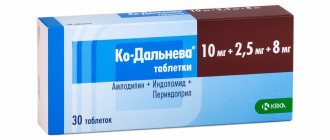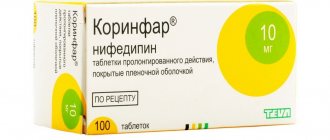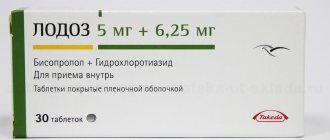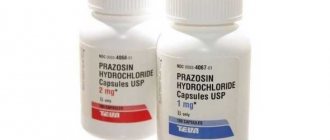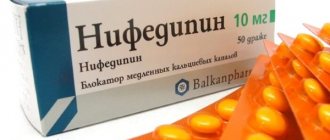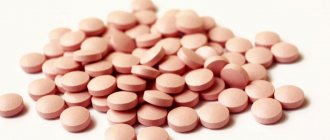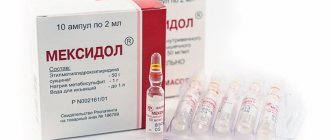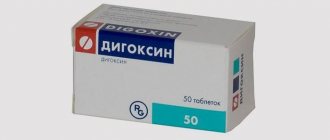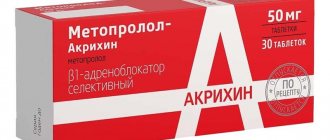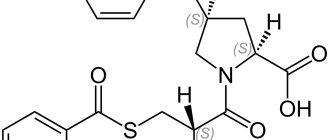The group of drugs that block calcium channels, which includes Nifedipine, has hypotensive and anti-ischemic properties. The effectiveness of these drugs has been proven in the treatment of primary (essential) hypertension, as well as in the case of renal and endocrine causes of high blood pressure. In this case, conventional dosage forms (solution and tablets) are prescribed to relieve a hypertensive crisis, and prolonged ones are used for long-term therapy.
Composition, release form and dosage
The blood pressure medicine Nifedipine is presented on the modern pharmaceutical market in the form of tablets, gel, capsules and a solution for placing droppers. The most widely popular is the tablet form of this drug.
The main active ingredient is nifedipine. Auxiliary ingredients may vary depending on the form of the drug. The dosages of the main component also differ:
- Nifedipine blood pressure tablets contain 10 or 20 mg of the active substance. Designed for internal use. The tablets contain components such as talc, Tween, povidone, milk sugar, and cellulose.
- Gel - contains nifedipine and lidocaine (2% each). Used to treat hemorrhoidal disease.
Nifedipine tablets for lowering blood pressure can have both short-term and prolonged effects. The first version of the drug is used to quickly normalize blood pressure, and the second is ideal for carrying out a full therapeutic course.
Nifedipine is one of the drugs used to treat blood pressure.
Pharmacodynamics: effect on blood pressure
The drug Nifedipine is quickly absorbed by the body through the circulatory system. The bioavailability of tablets ranges from 40% to 60%.
The maximum concentration of the active ingredients of the drug is observed 1-2 hours after taking the drug.
Nifedipine is characterized by the release of inactive liver metabolites. The half-life of the drug is about 12 hours. The drug is eliminated from the body using the renal apparatus.
With a long therapeutic course, the likelihood of addiction to Nifedipine increases and the effectiveness of treatment decreases. For this reason, it is recommended to take Nifedipine for high blood pressure for no more than 3 months in a row, after which it is necessary to take a mandatory break, the duration of which is determined individually by the doctor.
Pharmacokinetics of the drug
The drug Nifedipine is characterized by the presence of pronounced antianginal, hypotensive and vasodilating properties that help normalize blood pressure.
The active ingredients of these tablets inhibit the passage of calcium through slow vascular channels, which leads to their expansion.
Reduces endometrial tone and has a mild diuretic effect.
Nifedipine reduces blood pressure due to its following pharmacological properties:
- Decreased heart rate;
- Vasodilation;
- Activation of the circulatory system;
- Relaxation of smooth muscles;
- Improving blood circulation and microcirculation processes;
- Reduced oxygen demand of the heart and myocardium.
These tablets significantly reduce the load on the heart and improve the contractility of the heart muscle. The use of Nifedipine helps improve myocardial function, reduce blood and pulmonary pressure.
The medicine helps to dilate blood vessels, which leads to a decrease in blood pressure
Absolute and relative contraindications
The use of the drug "Nifedipine" is strictly contraindicated if:
- Idiopathic hypertrophic subaortic stenosis.
- Lactation.
- Pregnancy.
- Severe aortic and mitral stenosis.
- The period is 4 weeks after acute myocardial infarction.
- Hypotension with systolic blood pressure below 90 mm Hg.
- Cardiogenic shock, collapse.
- Tachycardia.
- Sick sinus syndrome.
- Age up to 18 years.
- Hypersensitivity to dihydropyridine derivatives or the drug "Nifedipine", from which the tablets can cause side effects.
- Decompensated heart failure.
By
What does Nifedipine help with?
Nifedipine tablets have the following clinical indications for use:
- Hypertrophic cardiomyopathy;
- Hypertonic disease;
- Angina;
- Any stage of arterial hypertension;
- Presence of arterial spasms;
- Raynaud's disease;
- Impaired functioning of the cardiovascular system of a congestive nature;
- Pulmonary hypertension;
- Atherosclerosis;
- Hypertensive crisis;
- Heart failure;
- Disruption of cerebral circulation processes;
- Phenomena of stagnant nature;
- Bronchial spasms;
- Stenosis of blood vessels;
- Ischemia of the heart muscle.
Nifedipine during pregnancy can often be prescribed to expectant mothers to reduce the tone of the uterus in order to prevent miscarriage and premature birth.
Nifedipine, available in gel form, is used to treat hemorrhoidal disease due to its analgesic and vasodilating properties, as well as its ability to lower rectal pressure.
This drug can be used for a long time to treat cardiovascular pathologies or periodically to quickly reduce blood pressure.
Nifedipine can be used for various vascular pathologies
Danger
Considering the decent list of additional chemical components, it is necessary to understand some of the features of use when determining the dosage of Nifedipine during pregnancy:
Advantages and disadvantages of the drug
Nifedipine for high blood pressure is very popular due to its following advantages:
- Lack of cumulation;
- Affordable, affordable cost of the drug;
- Wide range of actions and clinical indications;
- A variety of drug release forms, allowing each patient to choose the most suitable, optimal option;
- Possibility to choose between short-acting and long-acting tablets;
- Compatible with hemodialysis.
However, despite their undeniable advantages, Nifedipine tablets also have a number of disadvantages, which include the following:
- Wide range of contraindications and side effects;
- The ability of the active substances of the drug to penetrate breast milk and the placenta;
- Changes in the bioavailability of tablets depending on the individual characteristics of the patient’s body, which complicates the selection of the optimal dosage of the medication;
- Development of addiction to the drug with prolonged use;
- Increased bioavailability of Nifedipine after meals.
However, cardiologists often prescribe Nifedipine for high blood pressure to their patients, believing that the advantages of this drug significantly exceed its disadvantages!
The drug has a wide range of contraindications and side effects, so it should not be taken without a doctor’s prescription.
For whom the drug is contraindicated
Instructions for use of Nifedipine indicate the following contraindications to the use of this drug:
- Collapse;
- Myocardial infarction suffered less than a month ago;
- Cardiogenic shock;
- Narrowing of the arteries;
- Individual intolerance and hypersensitivity to the components included in the tablets;
- Idiopathic stenosis;
- Sinus node dysfunction;
- Cardiac dysfunction occurring in the decompensation stage;
- Rapid heart rate (tachycardia).
It is prohibited to use this remedy for the treatment of high blood pressure and other pathologies in young patients and women who are breastfeeding. During pregnancy, Nifedipine is prescribed exclusively in case of uterine hypertonicity. In other situations, these tablets are also contraindicated for expectant mothers, since their active ingredients penetrate the placenta and relax the muscle groups of the uterus, which can lead to dangerous consequences.
Contraindications for high blood pressure
Drugs that include Nifedipine are not recommended for the following pathologies:
- low blood pressure, shock or collapse;
- cardiac decompensation;
- heart attack (first 30 - 40 days);
- porphyria;
- individual intolerance;
- aortic stenosis;
- progressive angina.
Nifedipine is not prescribed to children under 16 years of age, since its safety for this age group has not been proven.
Pregnancy and the period of breastfeeding are also considered contraindications, but in the last months of gestation Nifedipine is used when there is a threat of eclampsia for health reasons.
Conditionally acceptable use
There are diseases in which Nifedipine for lowering blood pressure has no absolute contraindications, but can cause side effects. Such pathologies include:
- Diabetes;
- Disruption of cerebral circulation processes;
- Carrying out hemodialysis;
- Disorders of the functions of the cardiovascular system, occurring in a chronic form.
- Kidney pathologies;
- Impaired liver function;
- Hypertension in a malignant form.
For these diseases, the drug Nifedipine is prescribed only in exceptional cases, and the therapeutic course is carried out under strict medical supervision!
For kidney diseases, treatment with Nifedipine is carried out under strict medical supervision.
Side effects
- Cardiovascular system: feeling of heat, facial hyperemia, peripheral edema (ankles, feet, legs), tachycardia, syncope, excessive decrease in blood pressure, heart failure; in some cases, especially at the beginning of treatment, the appearance of angina attacks, requiring discontinuation of the drug;
- Central nervous system: increased fatigue, drowsiness, dizziness, headache; with long-term use in high doses - tremor, paresthesia of the limbs;
- Gastrointestinal tract, liver: dyspeptic disorders; with long-term treatment - liver dysfunction (increased activity of liver transaminases, intrahepatic cholestasis);
- Musculoskeletal system: myalgia, arthritis;
- Urinary system: increased daily diuresis, in patients with renal failure - deterioration of renal function;
- Hematopoietic organs: thrombocytopenia, leukopenia, thrombocytopenic purpura, anemia;
- Allergic reactions: exanthema, urticaria, itching, autoimmune hepatitis;
- Other: gum hyperplasia, hyperglycemia, changes in visual perception, flushing of the face, in older people - gynecomastia (completely disappearing after discontinuation of the drug).
Instructions for use for hypertension
The regimen for use and the optimal dose of Nifedipine tablets for hypertension is determined by the doctor on an individual basis.
The tablets are taken whole (without chewing or crushing), washed down with clean water. The use of this drug is not associated with food intake, however, it should be remembered that the use of Nifedipine after a meal increases its bioavailability.
If there is a need to quickly reduce sharply increased pressure, the tablet can be placed under the tongue and allowed to completely dissolve.
In most cases, therapy begins with the use of the drug at a dosage of 10 mg throughout the day. If there is no desired effect, the daily dose can be increased to 20 mg (1 tablet, 2 times a day, with a time interval of at least 12 hours).
The maximum permissible dosage of Nifedipine for hypertension is 40 mg per day.
The duration of the therapeutic course is determined individually for each patient. To avoid withdrawal syndrome, the dosage of the drug is gradually reduced.
Right help for hypertensive crisis
- Turn off bright light sources, provide the patient with peace and access to fresh air.
- Record the blood pressure level and, if necessary, take the medication prescribed by your doctor. First aid medications include: captopril 25 mg tablet (1 piece under the tongue). Begins to act in 15 minutes. You can also take clonidine 0.075 mg. (also under the tongue), Cordaflex 10 mg or furosemide 40 mg. The effect of the drugs will begin in 20-30 minutes.
- Continuously measure blood pressure every 15-30 minutes.
- Before the ambulance arrives, you can sit in a comfortable chair, and also do distracting procedures (mustard plaster on the calves or occipital area, hot bath for the feet, cold compresses for the head).
Read also: Hypertension and diabetes mellitus
After a hypertensive crisis, the patient needs rest and clear recommendations from a doctor.
Additional recommendations
In order for the treatment of high blood pressure with Nifedipine tablets to be as effective and safe as possible, you need to pay attention to the following recommendations from specialists:
- During the therapeutic course, refrain from drinking alcohol, as alcohol reduces the effectiveness of the drug.
- When carrying out long-term, course treatment (using extended-release tablets), take the medicine regularly, systematically, without allowing omissions.
- While taking this drug, refrain from driving vehicles and other activities that require concentration and reaction speed, since Nifedipine affects the central nervous system.
- Avoid drinking grapefruit juice, as this drink increases the likelihood of possible adverse reactions characteristic of this drug.
- Patients suffering from impaired liver function and cerebral circulatory processes should take tablets in smaller dosages, having agreed this issue with their doctor.
If you are planning a surgical procedure, you must notify the specialist in advance about taking Nifedipine.
Nifedipine is not compatible with alcohol
Adverse reactions to Nifedipine
During a course of long-term treatment, the following side effects of Nifedipine are possible:
- Bronchial spasms;
- Myalgia;
- Erectile dysfunction in men;
- Tremor of the upper and lower extremities;
- Photodermatitis;
- Redness of the skin of the hands and feet;
- Stool disorders (diarrhea or constipation);
- Hyperglycemia;
- Nausea and vomiting;
- Visual impairment;
- Flatulence, bloating;
- Skin itching;
- Gynecomastia (enlarged mammary glands in representatives of the stronger sex);
- Rash on the skin like urticaria;
- Impaired hearing function (ringing in the ears, muffled sound);
- Erythema;
- Headache;
- Attacks of dizziness;
- Insomnia.
- Rapid heartbeat (tachycardia);
- Thrombocytopenia (decreased blood clotting rates);
- Painful sensations localized in the heart area;
- Anemia;
- Heart rhythm disturbance (arrhythmia).
If the above-mentioned adverse reactions occur, you should stop taking the tablets and seek medical advice. You may need to adjust the dosage, dosage regimen, or select an analogue.
Nifedipine is dangerous for the heart
The drug is a calcium channel blocker that has antianginal and hypotensive effects. As a result of taking the drug, the pressure in the arteries decreases and an angina attack is blocked.
The pharmacological action of nifedipine leads to dilation of the peripheral vessels of the heart and coronary arteries. An incorrectly determined dosage, the presence of concomitant disorders in the patient and an individual reaction can lead to a strong decrease in blood pressure and excessive acceleration of blood flow to the myocardium.
The instructions for use mention side effects, but there is no warning about what consequences may occur as a result of taking the drug against the background of heart disease.
Important! According to the latest data, nifedipine is dangerous for the heart and can cause cardiac arrest and death.
Who declared him dangerous?
The regular session of the European Society of Cardiology was held in Lisbon (Portugal) in mid-March 2020. In addition to various topics on the treatment of heart diseases, the topic was brought up for discussion - nifedipine is dangerous for the heart.
In Russia, this topic was discussed, but did not receive due attention, since it turned out to be unprofitable for pharmaceutical companies. Despite the fact that the serious side effects of the drug have been proven, they continue to sell it in Russian pharmacies, and warnings about possible cardiac arrest never appeared in the instructions.
What medications contain
Nifedipine is an original drug containing the active substance of the same name. Based on this active component, other drugs are developed and produced, which can also be dangerous to human life.
Analogues are:
- Corinfar;
- Adalat;
- Cordipin;
- Phenigidine;
- Calgard retard;
- Nicardia;
- Nifebene;
- Sanfidipin.
In addition to the listed medications, many more drugs containing nifedipine are produced, which confirms the prevalence of the drug in our country.
Why is Nifedipine dangerous for the heart?
Studies relied on by European Community cardiologists in Portugal confirmed that more than 50% of patients taking drugs containing this active substance were diagnosed with a heart attack.
Rapid heartbeat and a significant decrease in blood pressure leads to disruption of myocardial functionality. The patient has an attack, if emergency assistance is not provided, death occurs within 5 to 10 minutes.
Cardiologists have found that a daily dosage of 60 mg of the drug is considered dangerous. The cause is a fatal deviation in the rhythm of the heart.
Note! It is impossible to unequivocally testify that taking drugs with nifedipine will lead to death. When prescribing a medication, the doctor must take into account the general condition of the body and the risks of side effects, and also determine the dosage individually.
What will a high dose cause?
It is quite natural - if in a standard dosage a medicine is dangerous for cardiac activity, then increasing the permissible dose means a manifold increase in the risk of death.
It is not recommended to increase the dosage of drugs in this category on your own. If the patient has bronchospasm, or a rare heart rhythm is observed, side effects of moderate severity may occur (tinnitus, swelling of the extremities, tachycardia, etc.).
However, in people with low blood pressure and normal bronchial function, an increased dosage causes an adverse reaction that turns into life-threatening processes.
Drug overdose
When taking a large number of Nifedipine blood pressure tablets, intoxication of the body develops, manifested by the following symptoms:
- Nausea;
- Vomit;
- Abnormal stool;
- Hyperemia of the skin of the face;
- Slow heartbeat (bradycardia);
- Severe attacks of headaches;
- A sharp decrease in blood pressure readings.
In case of such a clinical picture, indicating an overdose of Nifedipine, it is necessary to perform a gastric lavage, inducing artificial vomiting in the patient and allowing him to take the sorbent. Further treatment is symptomatic and is prescribed by the doctor individually.
Attacks of nausea are possible as a side effect of taking Nifedipine
Interaction with other drugs
Nifedipine can be used as a component of complex therapy for high blood pressure. However, the combination of these tablets with drugs from the following groups provokes the following effects:
- With Cimetidine - the development of hypotension, occurring in an acute form;
- With Quinidine - a decrease in the effectiveness of the latter;
- With magnesium sulfate - increased toxic effects of the drug;
- With antifungal medications - an increase in the active substances of Nifedipine in the blood plasma;
- With Digoxin - enhancing the effect of the latter drug;
- With Rifampicin - decreased effectiveness of Nifedipine tablets.
When combined with other antihypertensive drugs, the likelihood of a sharp decrease in blood pressure increases, up to the development of a hypotensive crisis.
